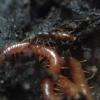Hi,
thanks for the info, I will go to a couple of locations, where according to old records, Pheidole antipodum was collected in the past during the weekend to see if I see any activity, that's why I was asking for the weather conditions and time of flight.
The only species (maybe two actually) of Pheidole I see flying regularly here are active between early to late April, and they are either Pheidole vigilans or something close to Pheidole variabilis, I do not have access to a microscope so I doubt I will be able to shed light on what actual species I am dealing with. I collected last year also a tiny species of Pheidole in my swimming pool in summer but I have not seen them fly this year.
Suburban Perth is largerly invaded by Pheidole megacephala and it is anyway very poor in Mymicines.
Cheers
Zyzzyx
Looking under stones and rocks in those areas should bear some fruit
I think your doing better than I am, in been able to name actual Pheidole species - I just know them as red headed/black body, or black or red Pheidole queens ![]()
I think that the ones I have, have not been studied and have no scientific names anyway
But they all range between 7-9mm in size
I found half of them under bricks in my backyard, and one on a windscreen of my car straight after a small flight at dawn.
Anyway these two queens have not arrived yet - after 3 days, frustrating when you pay for express post!
And the weekend is here, which means they could be stuck someone for another 2 days somewhere...
But since they are claustral founding queens in test tubes, and it's almost winter, it's not so bad






























